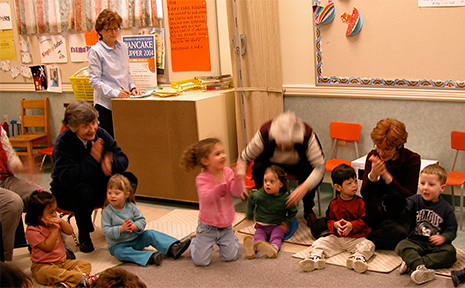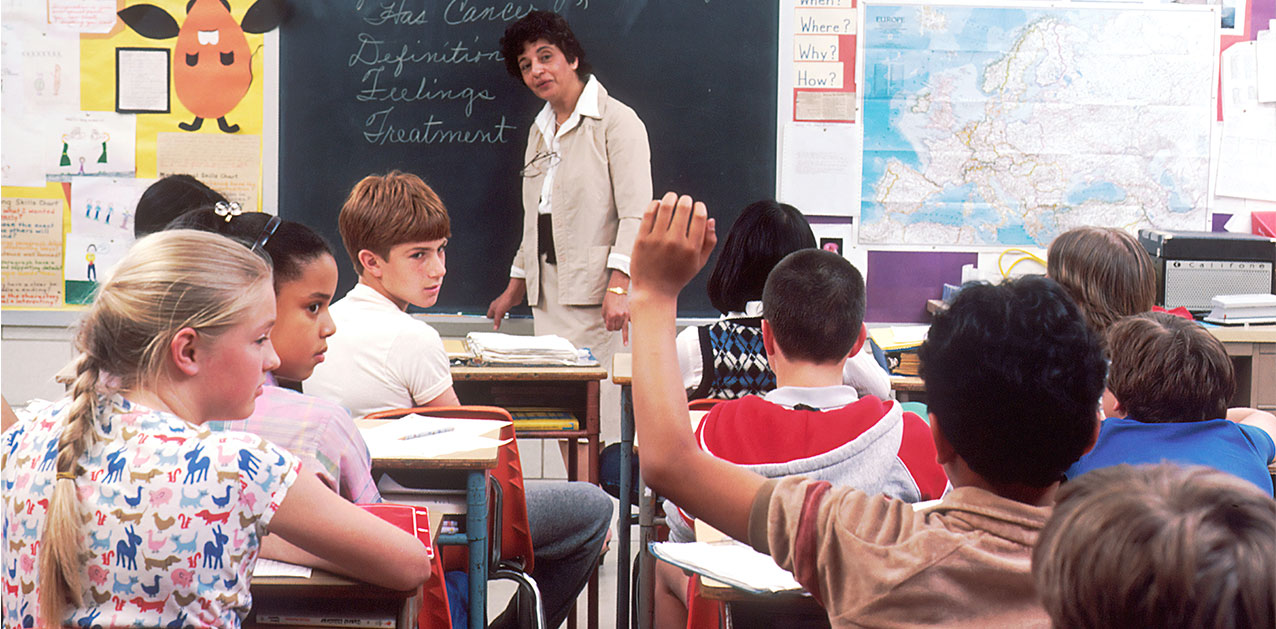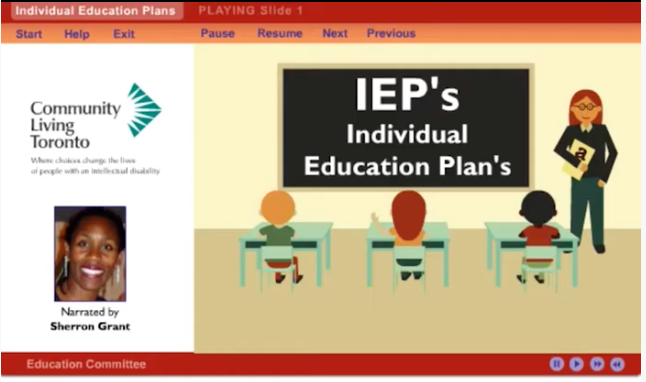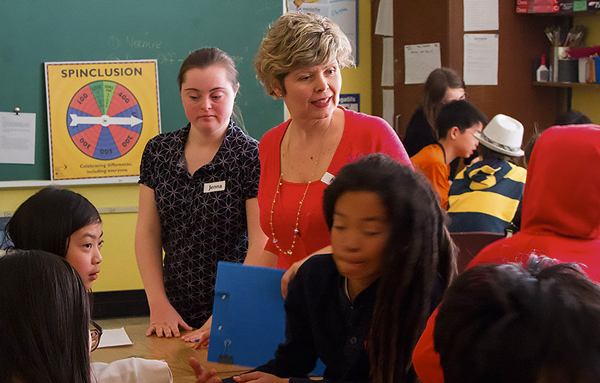Strategies that could help you save money for that trip or the new TV that you have always wanted.
Play – Flash version
Play – HTML5 version (updated browsers and tablets)

A Toolkit for Children with Challenging Behaviours in the Child Care Setting
This tool kit has been developed in response to growing concerns from the Toronto child care community about the challenges of providing care for children displaying extreme aggressive behaviour, in School Age programs. A working group was established to discuss strategies to address this issue.
The group consisted of staff from Toronto Children’s Services, including both the Municipal Child Care Services and Special Services Unit, working in collaboration with staff from Community Living Toronto.
The plan was to address the specific concerns in the quadrant and to create a pilot that other centers facing similar issues could model. It was decided that a “Common Practice” tool kit would be developed to focus on all aspects of the problems and to provide possible solutions. The group met over the course of six months to formulate additional strategies.
We recognize that not all challenges and possible solutions can be addressed in this document. We focused on the process. During the course of this project we felt that deciding which strategies to use is as important as determining the strategy itself. It is hoped that the steps provided will help to address challenges at the individual center level.

A trust is a legal arrangement where someone sets up an account to help someone else, called the beneficiary. The account is in the name of another person or persons. These persons, the trustees, must use the money or assets in the trust for the benefit of the beneficiary. The person who sets up the trust is called the settlor. Usually the settlor is a parent, some other relative, or a friend of the beneficiary. A settlor can also be the beneficiary of a trust. A trust may be set up while the settlor is living (an ‘inter vivos’ trust) or in the settlor’s will (a ‘testamentary’ trust). The person or persons who manage the money and assets are called the trustees. The bank account or assets are in the trustees’ names, but the trustees must use them for the beneficiary. If you use a trust for your relative with a disability, you must make sure that the trustees are reliable and honest.
When planning for the well being of our sons and daughters with disabilities, we are usually attempting to protect their entitlement to government support programs. The Henson Trust (also referred to as the Absolute Discretionary Trust) is used for that purpose.
Parents will often set up the Henson Trust in their wills. However, a Henson Trust can be set up by people who want to take care of a relative with a disability during their own lifetimes. This often happens where parents divorce and make a trust as part of the divorce settlement.
A Henson Trust gives the trustee absolute discretion to pay or not pay income and capital to the beneficiary. This means that the trustees are the only ones who can make decisions about giving money to the person with a disability or paying for things that will benefit him or her.
A Henson Trust can allow the trustees to pay money only to the person with a disability or to other beneficiaries as well. The other beneficiaries could include the other daughters and sons and grandchildren of the person who set up the trust. The trustees could invest the assets and allow income from the trust to build up. They could give more or less income and capital to each beneficiary.
Since a Henson Trust is an absolute discretionary trust, it gives the trustees a huge amount of responsibility. You need trustees who are honest and whom you can trust completely. Be very careful when you choose the people who are going to be the trustees. Look for someone who:
Consider that when family members or friends act alone as trustees, they do not always act in the best interest of the person with a disability. When a trustee is also a beneficiary of the trust, they can be in a conflict of interest and not make wise or fair decisions.
Once we have determined that we wish to provide for our son or daughter with a disability through the use of the Henson Trust, we need to turn our attention toward how we are going to provide money to the trust. There are a variety of resources within the reach of most families which can be used to fund the trust. They are:
The establishment of a regular savings program may be able to provide adequate funds to Henson Trust.
Provided that the parent’s estate is sufficiently large, it could provide for their own needs in their elder years, as well as having enough left over to fund the trust.
Siblings, Aunts and Uncle’s, Grandparents could be willing and able to provide money to fund the trust.
For the average family, life insurance may be the only way that they can leave a large lump sum to the trust by making small monthly payments. It is also possibly the only way of funding a trust that is guaranteed. The other resources mentioned above may not always be available but a paid-up life insurance policy can guarantee future funds.
Families of people with disabilities should examine the benefits and pitfalls of each of the funding methods mentioned here. A review of these resources with an Estate Planning Professional who specializes in planning for people with disabilities would be an excellent starting point.
Here are some suggestions to help you get started:
Special Needs Planning Group assists families in establishing plans which will provide their family members with a disability with a decent quality of life for their entire lifetime while at the same time, preserving their entitlement to government support programs.
Visit the website at: http://www.specialneedsplanning.ca
To find the regional office of the Ontario Ministry of Children, Community and Social Services, go to: http://www.mcss.gov.on.ca/en/mcss/programs/developmental/index.aspx
For information about home care, through the Local Health Integration Networks (LHINs): http://www.lhins.on.ca/

Going to school is a great journey with many successes and challenges for your child, family and your child’s educators. The school experience prepares your child for their growth into adulthood. These resources will help prepare your child for each stage in their education.
Mary Ierullo, ASD Consultant, School Support Program, Surrey Place Centre
Michelle Murphy, Autism Support Teacher, Autism Programs & Services Department, TCDSB
Melanie Randall, Community Liaison Service Navigator, Development Services Ontario
Excerpted from UN Conventions: Real Promises or Just Words
Presented by Defence for Children International – Canada and Community Living Toronto
Tuesday, May 8, 2018
Jessica Rotola and Sam Forbes talk about going to college
With the shift from institutions to individuals, it is important to consider how to get people involved in planning for their futures and expressing what they want.
This is a series of workshops and tipsheets designed to help plan for life after school. It is important to go through all of the workshops in order as each one prepares us for the next one.
A series of five online learning modules built around lived experience stories and practical strategies intended for educators from kindergarten through grade 12. Initiated and funded by the Ontario Ministry of Education EDU, the resource is designed to help educators and school board staff combat ableism and promote accessibility, inclusion, and full participation of students with disabilities in school communities. Project Inclusion

A parent handbook to help with understanding special education in Toronto and to ensure the acceptance and belonging of children with additional learning support needs. Handbook
 Play video
Play video
In this workshop, we will take a look at the Identification Placement Review Committee the purpose of which is to discuss the exceptionality (the type of disability) and the educational placement of a student within the education system in Ontario.
 Play video
Play video
In this workshop we will explore the Individual Education Plan, which is a written plan of learning goals and expectations for any student in the education system in Ontario who requires modifications or accommodations to the regular school program.
For parents, teachers and caregivers, pick-up and drop-off times at the child care centre or school can be a hectic part of the day. Read more
Professionals may become involved with your child for a number of reasons. Read more
Over time, as a parent, you may come across a wide range of professionals involved with your child. Read more
This website is designed to provide an overview of the most important concepts in education advocacy in Canada. It offers knowledge and tools for families and students with a disability seeking an inclusive education, and outlines the necessary supports needed to access it. http://www.inclusionadvocacy.ca/
Our mission is to disassemble the negativity and stigma that come when living with a disability through education and mentoring.
We offer hour long presentations on inclusivity vs accessibility as well as the history of people with disabilities. We also offer workshops on self esteem and advocacy to both elementary and high school students. https://www.disassemblingdisability.com/
A list of community organizations in Toronto that offer interpretation services. Read more
A game celebrating differences and including everyone


Person-directed planning helps you think about the life you want and your future.
With the help of a facilitator, it is a process which:
Guide to Readiness for Person-Directed Planning
Watch a video by Montage Support Services “Sounds Like a Plan”: Sounds like a PLAN ML and What’s Your Dream?
Taking the time and effort to plan out what the process will look like is a great strategy for setting the stage for successful interactions and excellent outcomes. A planning facilitator will become more comfortable interacting with you and your network if the necessary time has been taken to be well prepared. In the beginning, the facilitator guides the planning process and is then guided by you and your network.
The Person Directed Person Process
Voice is a critical part of supporting people with disabilities. We have to understand what a voice is. It is more than the physical sound that people make. It is more than language. It is communication in whatever form that takes. Read more
This guide on Person-Directed Planning has been written to assist families and people with developmental disabilities to plan for their future. Person-directed Planning puts the person with a disability at the heart of important decisions that affect their life. Planning Guide – plain language version
This Guide is a first step in recording what the ministry has learned to-date about person-directed planning and facilitation in Ontario. Given that person-directed planning and facilitation is an emerging profession, it is a first effort to capture and record a vision of what good practice looks like in Ontario. As the profession and practice of person-directed planning and facilitation develops further, it is expected that the content of the Guide may shift and change over time.Person Directed Planning Guide
This guide has been written to assist staff working in the developmental services sector and across other organizations in furthering their understanding of person directed planning and the role of the facilitator in the planning process. Guidance is provided on how to facilitate the development of a person directed plan and how to build capacity and commitment with a network of people supporting the person with the disability. Facilitators Guide to Person Directed Planning
Families for a Secure Future is dedicated to serving adults with developmental disabilities and supporting them to become more engaged in directing their lives, making choices and taking up full citizenship in the community.
A great resource with information and tools. They know the power of person-centred practices – not just because they have made it their mission to help others to understand and use them, but because they use them in their own lives and in the way they work together as a team. https://helensandersonassociates.com/
Profile template: Helen Sanderson Associates suggest that you create a one-page Profile of who you are. “A One Page Profile captures all the important information about a person on a single sheet of paper under three simple headings: what people appreciate about me, what’s important to me and how best to support me.”
Person-centred planning / review preparation booklet helps team members prepare for the gathering. Whether they are going to be present at the review or have been asked to make a contribution, there are things that they will need to think about in advance. This booklet will help them to think about their contribution to the meeting. Person Centred Review Booklet
A Person-Centred Review uses person-centred thinking tools to explore what is happening from the person’s perspective and from other people’s perspectives. This results in outcomes and actions for person-centred change and ensures that a range of people are involved when the review is happening, and that their views and ideas are recorded in a structured, step-by-step way. Person-Centred Review
Watch a video by Montage Support Services talking about Person Centre Reviews PERSON CENTRED REVIEWS
The following resources have been compiled for the purpose of facilitating research when exploring potential services, discovering new opportunities or browsing for ideas when planning. Some programs may have specific criteria or program requirements for admission.
Person Directed Planning Resources
The Enabling Person-Directed Planning for AAC Users guidebook is designed to help persons who use augmentative and alternative communication take an active role in the person-directed planning process. The guidebook outlines a 5-phase process, based on established best-practices in AAC and transition planning for persons with disabilities, for developing partner communication strategies with planning recipients who use AAC. Read more
A list of community organizations in Toronto that offer interpretation services. Read more
Special Needs Planning Group assists families in establishing plans which will provide their family members with a disability with a decent quality of life for their entire lifetime while at the same time, preserving their entitlement to government support programs. http://www.specialneedsplanning.ca
MyCommunityHub.ca an online registration and payment space for activities, classes, programs, workshops, respite and camps offered by Developmental Service Agencies across Ontario. MyCommunityHub.ca
Financial and Legal Issues Resources and information related to financial planning, ODSP, RDSP’s, wills, trusts, power of attorneys and estate planning for individuals with disabilities and their families. Read more
Resource Directories Links to resource directories across Ontario Read more
Housing Options for living independently Read more
Community Participation Supports Community Participation Supports Information for adults with an intellectual disability in Ontario Read more
Employment Resources, tools supporting successful employment and the business case for hiring a person with a disability Read more
A workshop providing tips when using the internet, including how to stay safe on the Internet, how to communicate online, using online gaming and safely using adult content on the Internet.

We spend much of our day consciously and unconsciously observing people, activities, elements of the environment and countless other things. Early childhood educators utilize their skills of observation on a continual basis. Within a matter of seconds an educator can assess the safety of an environment whether it is a playroom or playground, do a head count of children, observe children in play and determine what routine or transition is about to occur according to the daily schedule.
This may appear effortless to some, however it usually takes time and practice to develop these important skills and to find a method of observation that is tailor made for your teaching style. A good educator will recognize that regular observations can enhance their own teaching abilities and ultimately will have a positive impact on the children they support. Don’t wait until there is a concern or problem in your program to begin the process of observation. Rather, consider it a foundation block that is as much part of your program as your daily schedule.
Regular observations allow you to develop insight into all aspects of the program from the playroom environment to interactions between the children and adults. With knowledge gained through observations you’ll be better equipped to answer questions about the children in your program and share information with parents and professionals. You can often begin conversations with parents by discussing observations you have made of their son or daughter to discover their likes / dislikes etc. It also may aid you in identifying very specific triggers or events that may be causing a child to engage in problem behaviours. This type of information collection is a critical component of developing formal plans to assist children during times of difficulty and to customize specialized programming.
Learning environments that promote healthy child development are based upon the successful integration of techniques/ adaptations that are implemented by the teacher through the process of regular observation. We know each child is a unique learner and will absorb learning experiences and process information at their own pace. As educators we have developed many teaching strategies and adaptations to address individual learning styles with the goal of helping young children to succeed.
While one child may be comfortable with simple verbal instructions to complete a particular task, another child may benefit from a more direct approach such as watching another child or adult complete the requested task. Teachers who devote time for observation are motivated to provide learning experiences that children enjoy and are challenged by. The classroom is not a stagnate environment. It is ever-changing and in order to maintain this level of growth it is essential to utilize your daily observations of children and environment.
Systematic observations made by sensitive and knowledgeable educators are more powerful than any other technique in determining a child’s strengths and needs; knowing what to observe and recording the information for later reference is critical to good observation. Often, observations can be done unobtrusively in the child’s classroom setting as she interacts with teachers, plays, and participates in regular transitions such as meal times. At other times, situations may have to be contrived to provide the information about specific behaviours. Deciding what to observe determines whether the observation can be natural or contrived. We observe children to determine their level of interest in and response to the environment, their ability to solve problems, communication skills, motor functioning, and social skills.
Children, even when participating in a quiet learning experience/ activity are in a constant state of learning through the process of independent play or by interacting with others, their play materials, and the environment. The educator, when time permits, is able to remove herself from direct teaching to that of the role of the observer. This unique opportunity allows the educator to observe relations between the children, developmental levels of the children, the classroom set-up, popular and unpopular activities and so on. The list or purpose of observing can be endless and it is best to have a focus or goal in mind when you want to observe the children. You should also consider scheduling a set time each week that you or a team member can devote to classroom observations. Try to select a day and rotate the times from the morning to the afternoon so you’re able to capture all aspects of the program.
Key to all observation techniques is a clear set of definitions of what is being observed. For example, if tantrums are to be observed, what constitutes a tantrum must be specified. What does a tantrum look like? How will you know it is occurring? Does a tantrum involve whining, turning away, crying, hitting, throwing things, refusing attempts to comfort, or some combination of all these things? Prior to the observation these categories and their definitions must be developed, and all those using the observational instrument must be trained and skilled in its use.
You may want to explore several observation techniques to select one that you are comfortable with. Remember that you’re not limited to only one technique and you’ll find that you need a few techniques in order to successfully observe children in your program and to record your findings.
Several strategies are used to structure information gathered during observations. These may include event recording, time sampling, checklists and rating scales, and coded observations. Observations are best performed in a child’s natural setting such as their home or classroom and if possible, by a person who is familiar with the child.
More than a few issues and cautions have been delineated that should be considered when using observational techniques:
With the advancement in technology in the classroom setting, specialized equipment such as audio/video recorders may assist you in this process (it is important to be aware of your centre policies/procedures regarding consent of taping/recording within the classroom setting).
Event Recordings: may be continuous, narrative records of the child’s behaviours and responses or a detailed recording of a single event. For example, behaviours of concern such as temper tantrums may occur regularly; it is important to capture the details of the antecedent condition (what happens right before the tantrum occurs), the behaviour during the tantrum, and the consequent events (what happens immediately after the tantrum) in order to develop appropriate management and treatment plans.
Time Sampling: often called interval recording, is used when behaviours occur more frequently and the observer is interested in the frequency of occurrence. To develop a more complete picture of a child’s behaviour you may decide to observe the child using a time sampling approach. Prior to the observation, you need to develop a form for recording observations and select the times you want to observe. Forms are usually quite simple; typically divided into smaller intervals of 15 seconds to 1 minute, and behaviours may be preprinted on the form so that the observer can record what is occurring during each interval. The observation period may last from several minutes at different times throughout the day to an hour or more every day for several weeks. At the end of the observation period, the percentage of time that the child has spent in the behaviours of interest can be determined.
Checklists and Rating Scales: can be used to determine the presence or absence of a particular skill or behaviour or to rate the quality of the behaviour or setting. Checklists of developmental milestones can be used; children are observed at play to determine which skills they have mastered, which are emerging, and which remained to be learned.
Coded Observations: are often used to study multiple interactions or behaviours occurring within a specified period of time. In observations of this kind, the behaviours of interest are specified prior to the observations. The number and types of behaviours can range from very few, simple behaviours to many complex interactional patterns.
All teachers need to develop skill as observers. They need to see and record as accurately and as objectively as possible what is happening in situations. Teachers learn most about children by studying their behaviour directly. By learning to observe with objectivity, to make careflul notes, and to og over these thoughtfully, a teacher increases her understanding of a child’s behaviour.
Bessie: No, it’s mine! (and turns away from Bumble holding the car)
Bumble hits Bessie on her back and Bessie screams.
Mrs. Panda approaches the children and says: I can see you both are angry. Take a deep breath. [YELLOW light is shown] You’ll each get a chance to tell me what happened. Bumble, here’s the talking stick.
Bumble: She had my car so I tried to get it back.
Mrs. Panda: Were you playing with it?
Bumble: Yes, I just came back from getting some blocks to build my house.
Mrs. Panda: So, you had the car but you put it down to get the blocks?
Bumble: Yes.
Mrs. Panda: Bumble, please pass the talking stick to Bessie. (He passes it)
Bessie: But I had the car!
Mrs. Panda: So, you didn’t know that Bumble was using it?
Bessie: No, I just got it.
Mrs. Panda: So is there any way that you two can play with the car and the blocks together? [GREEN light is shown]
Bessie and Bumble: I don’t know.
Mrs. Panda: What about Bessie using the car while Bumble builds a house? Then when the house is done, Bessie you can drive over to the house and build something else while you use the car.
Bessie and Bumble: Okay, let’s go.
Bessie continues to play.
Mrs. Panda comes up to Bessie and says: Bessie, it’s time to tidy up.
Bessie: No, I don’t want to!
Mrs. Panda: It’s circle time now.
Bessie screams and throws blocks.
Mrs. Panda: Bessie, I see you are at a red light. I know you like playing with blocks.
Bessie: Yeah, and I don’t want to tidy up.
Mrs. Panda: Well, let’s see if we can get you to a yellow light. Let’s do the finger pull. We all enjoy playing but it’s everyone’s responsibility to follow the rules and tidy up so we can have circle. Remember our rules keep us safe and help us to know what to expect. What can you do to be helpful now that you’re at a green light.
Bessie: I can tidy up and come to circle.